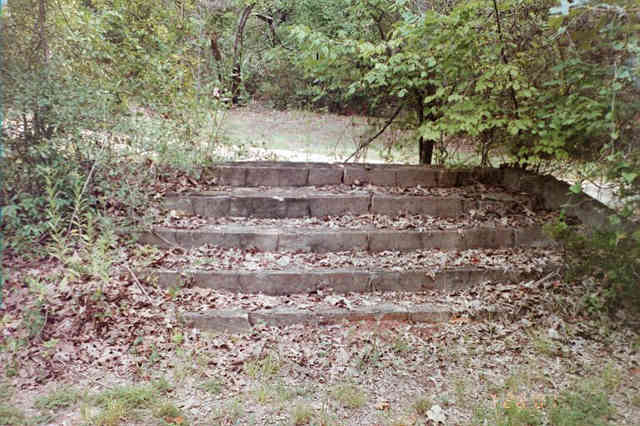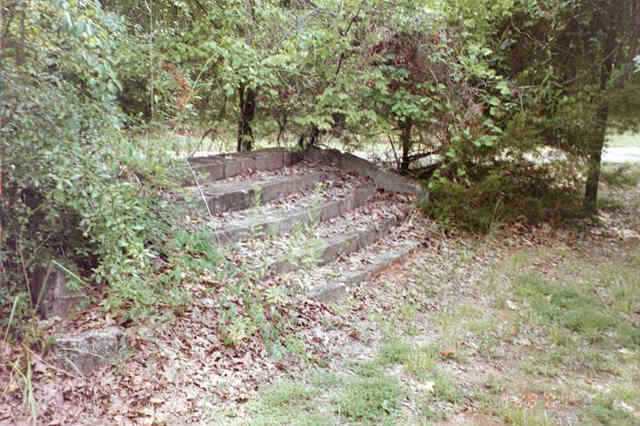See who's visiting this page. |
|

Profiles of the Past
Ruins of Cement Baron's Home Mark Old White Cliffs
by Harold Mabry
 cell padding=1
cell padding=1
An empty concrete vault stands sentinel over the ruins of the many foundations that mark the site of White Cliffs, one of the oldest settlements in Sevier county.
Once included in the office building, te vault stands within a stone's throw of the elegant circular steps of Will Kelly's home, which was also graced by a rock walled wine cellar. Perched atop the majestic White Cliff that rises almost vertically from the east bank of Little River, this residence mst indeed have been a setting befitting a cement baron.
These cliffs have a long and interesting history. Its limestone was famous long before the Civil War. It was prepared in crude fashion by simply scooping a hole in the soft limestone rock, filling it with pieces of the rock and building a fire beneath. The lime thus secured was shipped by steamboat to New Orleans.
White Cliffs was once a steamboat landing. The steamboats would come up Little River to Hood's Landing and blow their whistles which could be heard in Brownstown.
About 1895, two steamboat captains, John and Will Kelly, who had navigated Little River and become familiar with White Cliffs, secured the interest of some Chicago capitalists and started a cement factory there. It was never very successful and the Kellys were forced out. The place was taken over by some Dutch capitalists. They invested more than two million dollars and erected an immense plant. The buildings of this plant and the attendant town totaled over 100 buildings, including a school and two hotels. (One of these, the Schockenbach, with 50 rooms, was used for a school after the decline of White Cliffs, Will Boggs was the teacher.)
They turned out good cement and some of it may be seen in Little Rock. The basement of the state capitol was constructed of cement from this plant.
However, the Dutch brought with them old country ideas which doomed them to failure in the fierce competition of American firms using modern methods. Also, a vast amount of fuel is necessary to manufacture cement, and the cost of this was prohibitive. The railroad being on the opposite side (of Little River), it was necessary to transport coal across the river in buckets that ran on a cable. This was too expensive and finally the plant was abandoned.
Frank Lane of Paragould bought the property, wrecked the buildings and scrapped the machinery.
In the teens the Kruppendoff and Tuttle White Cliffs Products Co. made agricultural lime, concrete filler, asphalt filler, road coating and a whiting, said to be a superior paint pigment. They established an extensive plant and operated for several years.
The rock which gave White Cliffs its name is ninety percent limestone, so soft it can be easily broken with the hands and rapidly disintegrates when exposed to the elements. It was formed from the remains of marine life millions of years ago when this was the shoreline of the Gulf of Mexico. Shark teeth and fossil sea urchins are relatively easy found. Fossilized bones of mosasaurs (giant marine reptiles, up to 60 to 70 feet long) of the Cretaceous period are reported to have been found. There have also been reports of other fossils being found, including a coiled snake, among the billions of fossil sea shells.
Lloyd Garrison of Brownstown tells of finding a large fossilized sea turtle.
Mrs. Belle McGoodwin, also of Brownstown, states that White Cliffs was settled by Grandma Walker and her family. She had the first flower garden in Southwest Arkansas. At that time White Cliffs was a steamboat landing and freight was hauled many miles overland to this point on Little River. When the teamsters became ill they would go to Grandma Walker's for help.
When they returned again the grateful freighters would bring her flowers for her garden.
The jonquils, buttercups and narcissus of southwest Arkansas originally came from this garden
There is a family burying ground on this farm. Some of the dates on the gravestones back to the seventeen hundreds.
One of the many stories of the White Cliffs concerns a lass of that section who had a most devoted suitor. One day they were walking on the cliffs and the lover proposed again.
"Let's see if you have the courage," replied the girl. "If you have nerve enough to jump off the cliffs, I'll marry you."
The awesome plunge down into the river held no terror for the lovesick swain. He jumped and by some miracle, extremely wet but still intact, clambered up the cliffs to claim his bride.
"No chance," said the girl when he finally reached her side.
Do ;you suppose I would marry a man who is fool enough to jump into the river just because someone asked him to?"
(Originally printed in the DeQueen Bee, DeQueen Arkansas Thursday July 8, 1965)
Links to other sites with White Cliffs information.
OLD PICTURE OF THE LIMESTONE PLANT AT WHITE CLIFFS
For information on an early family of White Cliffs, Arkansas the Haizlip Family and Inglish Family please follow the link provided here.